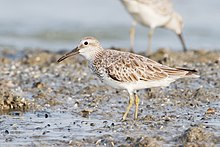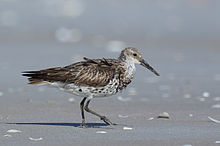Great knot
| Great knot | |
|---|---|

| |
| Nonbreeding | |

| |
| Breeding | |
| Scientific classification | |
| Domain: | Eukaryota |
| Kingdom: | Animalia |
| Phylum: | Chordata |
| Class: | Aves |
| Order: | Charadriiformes |
| Family: | Scolopacidae |
| Genus: | Calidris |
| Species: | C. tenuirostris
|
| Binomial name | |
| Calidris tenuirostris (Horsfield, 1821)
| |
The great knot (Calidris tenuirostris) is a small
Etymology
The genus name is from Ancient Greek kalidris or skalidris, a term used by Aristotle for some grey-coloured waterside birds. The specific tenuirostris is from Latin tenuis "slender" and rostrum "bill".[3]
Distribution
Their breeding habitat is tundra in northeast Siberia, Russia. They nest on the ground laying about four eggs in a ground scrape. They are strongly migratory wintering on coasts in southern Asia through to Australia. This species forms enormous flocks in winter.
The species is also recorded in low numbers in western Alaska, United States, most years, and has occurred as a vagrant in British Columbia, Canada, and in Oregon, West Virginia, and Maine, in the U.S.
Taxonomy and description

Calidris tenuirostris, commonly known as the great knot, is the largest species of the
This species has short dark legs and a medium-length thin dark bill. Breeding adults have mottled greyish upper parts with some rufous feathering. The face, throat and breast are heavily spotted black, and there are also some streaks on the rear belly. In winter the plumage becomes uniformly pale grey above.
It is distinguished from the red knot by its breeding plumage, in which the latter has a distinctive red face, throat and breast. In other plumages, the great knot can be identified by its larger size, longer bill, deeper chest, and the more streaked upper parts.
Behaviour
These birds forage on
Conservation status
The great knot is one of the species to which the
Australia
Since 5 May 2016 and as of August 2023[update], the great knot is listed as
Under
References
- . Retrieved 12 November 2021.
- ^ Species Profile and Threats Database. Department of Climate Change, Energy, the Environment and Water, Australian Government. 2023. Archived from the original on 23 August 2023. Retrieved 23 August 2023.licence.
 Text may have been copied from this source, which is available under a Attribution 3.0 Australia (CC BY 3.0 AU)
Text may have been copied from this source, which is available under a Attribution 3.0 Australia (CC BY 3.0 AU) - ISBN 978-1-4081-2501-4.
- ^ Jeyarajasingam, A. (2012). A field guide to the birds of Peninsular Malaysia and Singapore. Oxford University Press.
- ^ Van Gils, J., P. Wiersma, G. M. Kirwan, and C. J. Sharpe (2020). Great Knot (Calidris tenuirostris), version 1.0. In Birds of the World (J. del Hoyo, A. Elliott, J. Sargatal, D. A. Christie, and E. de Juana, Editors). Cornell Lab of Ornithology, Ithaca, NY, USA.
- ISBN 978-1-4200-6444-5.
- ISSN 0006-3207.
- ^ "Researchers find 26 Australian species recovered from the brink of extinction". ABC News. 24 February 2023. Retrieved 23 August 2023.
External links
 Media related to Calidris tenuirostris at Wikimedia Commons
Media related to Calidris tenuirostris at Wikimedia Commons Data related to Calidris tenuirostris at Wikispecies
Data related to Calidris tenuirostris at Wikispecies- Great knot – Photos on Oiseaux.net


